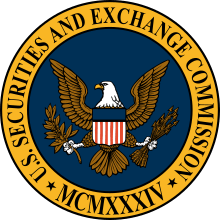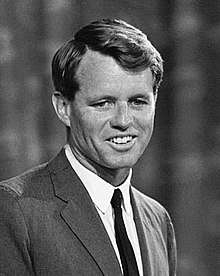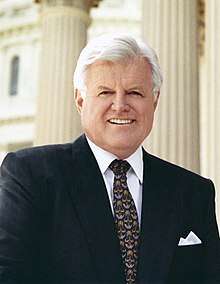Joseph P. Kennedy Sr.
Joseph Patrick Kennedy Sr. (September 6, 1888 – November 18, 1969) was an American businessman, investor, and politician known for his high-profile positions in United States government and for the political and other achievements of his children.
Joseph P. Kennedy | |
|---|---|
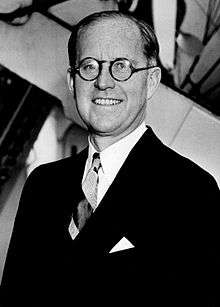 | |
| United States Ambassador to the United Kingdom | |
| In office March 8, 1938 – October 22, 1940 | |
| President | Franklin D. Roosevelt |
| Preceded by | Robert Worth Bingham |
| Succeeded by | John G. Winant |
| 1st Chair of the U.S. Maritime Commission | |
| In office April 14, 1937 – February 19, 1938 | |
| President | Franklin D. Roosevelt |
| Preceded by | Position established |
| Succeeded by | Emory S. Land |
| 1st Chair of the U.S. Securities and Exchange Commission | |
| In office June 30, 1934 – September 23, 1935 | |
| President | Franklin D. Roosevelt |
| Preceded by | Position established |
| Succeeded by | James M. Landis |
| Personal details | |
| Born | Joseph Patrick Kennedy September 6, 1888 Boston, Massachusetts, U.S. |
| Died | November 18, 1969 (aged 81) Hyannis Port, Massachusetts, U.S. |
| Resting place | Holyhood Cemetery |
| Political party | Democratic |
| Spouse(s) | |
| Children | |
| Parents | P. J. Kennedy Mary Augusta Hickey |
| Relatives | See Kennedy family |
| Education | Harvard University (BA) |
| Signature | |
Kennedy was born to a political family in East Boston, Massachusetts. He made a large fortune as a stock market and commodity investor and later rolled over his profits by investing in real estate and a wide range of business industries across the United States. During World War I, he was an assistant general manager of a Boston area Bethlehem Steel shipyard; through this position, he became acquainted with Franklin D. Roosevelt, who was the Assistant Secretary of the Navy. In the 1920s, Kennedy made huge profits by reorganizing and refinancing several Hollywood studios; several acquisitions were ultimately merged into Radio-Keith-Orpheum (RKO) studios.[1] Kennedy increased his fortune with distribution rights for Scotch whisky. He owned the largest privately owned building in the country, Chicago's Merchandise Mart.
Kennedy was a leading member of the Democratic Party and of the Irish Catholic community. President Franklin D. Roosevelt appointed Kennedy to be the first chairman of the U.S. Securities and Exchange Commission (SEC), which he led from 1934 to 1935. Kennedy later directed the Maritime Commission. Kennedy served as the United States Ambassador to the United Kingdom from 1938 until late 1940. With the outbreak of World War II in September 1939, Kennedy was pessimistic about Britain's ability to survive Nazi Germany's attacks. During the Battle of Britain in November 1940, Kennedy publicly suggested that "Democracy is finished in England. It may be here [in the United States]".[2] Following this controversy, Kennedy resigned his position.
Kennedy was married to Rose Kennedy. During his later life he was heavily involved in the political careers of his sons. Three of Kennedy's sons attained distinguished political positions: John F. Kennedy (1917–1963) served as a U.S. Senator from Massachusetts and as President of the United States, Robert F. Kennedy (1925–1968) served as Attorney General and as a U.S. Senator from New York, and Ted Kennedy (1932–2009) also served as a U.S. Senator from Massachusetts.
Background, early life, and education
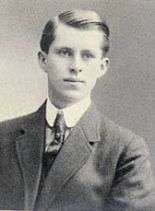
Joseph Patrick Kennedy was born in 1888 in Boston, Massachusetts. Kennedy was the elder son of Mary Augusta (Hickey) Kennedy and businessman and politician Patrick Joseph "P.J." Kennedy. He had a younger brother, Francis, and two younger sisters, Mary and Margaret. All four of Joe's grandparents had immigrated to Massachusetts in the 1840s to escape the Irish famine. He was born into a highly sectarian society, where Irish Catholics were excluded by upper-class Boston Brahmins. Boston Irish thus became active in the Democratic Party, which included P.J. and numerous relatives. P.J. Kennedy was an accomplished businessman. A successful saloon business, investment ventures, and an influential role in local politics enabled him to provide a comfortable lifestyle for his family. His mother encouraged Joe to attend the Boston Latin School, where he was a below-average scholar but was popular among his classmates, winning election as class president and playing on the school baseball team.
Kennedy followed in the footsteps of elder cousins by attending Harvard College. He focused on becoming a social leader, working energetically to gain admittance to the prestigious Hasty Pudding Club. While at Harvard he joined the Delta Upsilon International fraternity and played on the baseball team, but he was blackballed from the Porcellian Club. Kennedy graduated from Harvard in 1912[3] with a bachelor's degree in economics.[4]
On October 7, 1914, Kennedy married Rose Fitzgerald,[5] the eldest daughter of Boston Mayor John F. "Honey Fitz" Fitzgerald and Mary Josephine "Josie" Hannon.[6]
Business career
Kennedy pursued a career in business and investing. In his mid- to late 20s, he made a large fortune as a stock market and commodity investor; he reinvested in real estate and a wide range of business industries. He did not build a significant business from scratch, but his timing as both buyer and seller was usually excellent.[7]
Various criminals, such as Frank Costello, have boasted they worked with Kennedy in mysterious bootlegging operations during Prohibition.[8] Scholars dismiss the claims. The most recent and most thorough biographer David Nasaw asserts that no credible evidence has been found to link Kennedy to bootlegging activities.[9] When Fortune magazine published its first list of the richest people in the United States in 1957, it placed Kennedy in the $200–400 million group.[10][11]
Early ventures

Kennedy's first job after graduating from Harvard was a position as a state-employed bank examiner; this job allowed him to learn a great deal about the banking industry. In 1913, the Columbia Trust Bank, in which his father held a significant share, was under threat of takeover. Kennedy borrowed $45,000 ($1,164,091 today)[10] from family and friends and bought back control. At the age of 25, he was rewarded by being elected the bank's president. Kennedy told the press he was "the youngest" bank president in America.[12]
Kennedy emerged as a highly successful entrepreneur who had an eye for value. For example, he was a real estate investor who turned a handsome profit from ownership of Old Colony Realty Associates, Inc., which bought distressed real estate.[13]
During World War I, President Woodrow Wilson asked the Intercontinental Rubber Company—owned by Bernard Baruch, J. P. Morgan and Kennedy—to grow guayule. Guayule is a plant that produces latex that can be used to make rubber. Many feared the German navy might blockade rubber shipments from Asia. As a result, Intercontinental established the Continental Farm and the little town of Continental in southeastern Arizona in 1916. The guayule-growing operation did not continue long; in 1922 the Continental Farm was sold to Queen Wilhelmina of the Netherlands, who rented the fields to cotton farmers for several years.[14]
Although he was skeptical of American involvement in the war, Kennedy sought to participate in wartime production as an assistant general manager of Fore River a major Bethlehem Steel shipyard in Quincy, Massachusetts. There he oversaw the production of transports and warships. Through this job, he became acquainted with Assistant Secretary of the Navy Franklin Delano Roosevelt.
Wall Street and stock market investments
In 1919, Kennedy joined the prominent stock brokerage firm of Hayden, Stone & Co. where he became an expert dealing in the unregulated stock market of the day, engaging in tactics that were later considered to be insider trading and market manipulation. He happened to be on the corner of Wall and Broad Streets at the moment of the Wall Street bombing on September 16, 1920, and was thrown to the ground by the force of the blast.[15] In 1923, he left Hayden and set up his own investment company. Kennedy subsequently became a multi-millionaire during the bull market of the 1920s and even wealthier as a result of taking "short" positions in 1929.
David M. Kennedy (no relation to this Kennedy), described the Wall Street of the Kennedy era as follows:
[It] was a strikingly information-starved environment. Many firms whose securities were publicly traded published no regular reports or issued reports whose data were so arbitrarily selected and capriciously audited as to be worse than useless. It was this circumstance that had conferred such awesome power on a handful of investment bankers like J. P. Morgan, because they commanded a virtual monopoly of the information necessary for making sound financial decisions. Especially in the secondary markets, where reliable information was all but impossible for the average investor to come by, opportunities abounded for insider manipulation and wildcat speculation.
1929 Wall Street Crash
Kennedy formed alliances with several other Irish-Catholic investors, including Charles E. Mitchell, Michael J. Meehan, and Bernard Smith. He helped establish a "stock pool" to control trading in the stock of glassmaker Libbey-Owens-Ford. The arrangement drove up the value of the pool operators' holdings in the stock by using insider information and the public's lack of knowledge. Pool operators would bribe journalists to present information in the most advantageous manner. Pool operators tried to corner a stock and drive the price up, or drive the price down with a "bear raid". Kennedy got into a bidding war for control of Yellow Cab Company.[16]
Kennedy later claimed he understood that the rampant stock speculation of the late 1920s would lead to a market crash. Supposedly, he said that he knew it was time to get out of the market when he received stock tips from a shoe-shine boy.[17] Kennedy survived the crash "because he possessed a passion for facts, a complete lack of sentiment and a marvelous sense of timing".[18]
During the Great Depression, Kennedy vastly increased his fortune by investing most of his money in real estate. In 1929, Kennedy's fortune was estimated to be $4 million (equivalent to $59.6 million today).[10] By 1935, his wealth had increased to $180 million (equivalent to $3.36 billion today).[10]
Investments in entertainment, shipping, and real estate
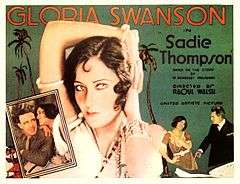
Kennedy made huge profits from reorganizing and refinancing several Hollywood film studios. Film production in the U.S. was much more decentralized than it is today, with many different movie studios producing film product. One small studio was Film Booking Offices of America (or FBO), which specialized in Westerns produced cheaply. Its owner was in financial trouble, and asked Kennedy to help find a new owner. Kennedy formed his own group of investors and bought it for $1.5 million.
In March 1926, Kennedy moved to Hollywood to focus on running film studios. At that time, film studios were permitted to own exhibition companies, which were necessary to get their films on local screens. With that in mind, in a hostile buyout, he acquired the Keith-Albee-Orpheum Theaters Corporation (KAO), which had more than 700 vaudeville theaters across the United States that had begun showing movies. He later purchased another production studio called Pathe Exchange, and merged those two entities with Cecil B. DeMille's Producers Distributing Corporation in March 1927.
In August 1928, he unsuccessfully tried to run First National Pictures.[20] In October 1928, he formally merged his film companies FBO and KAO to form Radio-Keith-Orpheum (RKO) and made a large amount of money in the process. Then, keen to buy the Pantages Theatre chain, which had 63 profitable theaters, Kennedy made an offer of $8 million ($119 million today).[10] It was declined. He then stopped distributing his movies to Pantages. Still, Alexander Pantages declined to sell. However, when Pantages was later charged and tried for rape, his reputation took a battering, and he accepted Kennedy's revised offer of $3.5 million ($52.1 million today).[10] Pantages, who claimed that Kennedy had "set him up", was later found not guilty at a second trial. The girl who had accused Pantages of rape, Eunice Pringle, confessed on her deathbed that Kennedy was the mastermind of the plot to frame Pantages.[21]
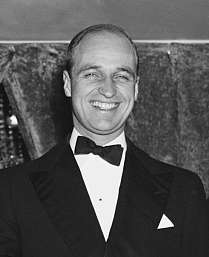
Many estimate that Kennedy made over $5 million ($74.4 million today)[10] from his investments in Hollywood. During his three-year affair with film star Gloria Swanson,[23] he arranged the financing for her films The Love of Sunya (1927) and the ill-fated Queen Kelly (1928). The duo also used Hollywood's famous "body sculptor", masseuse Sylvia of Hollywood.[23] Their relationship ended when Swanson discovered that an expensive gift from Kennedy had been charged to her account.[24]
A recurring rumor alleges that he made money in bootlegging illegal liquor during Prohibition. Historians have not found credible evidence of this. On the contrary, there is abundant evidence that as the end of prohibition loomed (in 1933), Kennedy invested heavily in Scottish distilleries. As soon as it became legal he imported large shipments of high-priced Scotch and made a large profit. Various contradictory "bootlegging" stories circulated but historians have not accepted them. At the start of the Franklin Roosevelt administration in March 1933, Kennedy and future Congressman James Roosevelt II founded Somerset Importers, an entity that acted as the exclusive American agent for Haig & Haig Scotch, Gordon's Dry Gin and Dewar's Scotch. Kennedy kept his Somerset company for years.[25] (Kennedy himself drank little alcohol. He so disapproved of what he considered a stereotypical Irish vice that he offered his sons $1,000 to not drink until they turned 21.[26])
Kennedy invested his profits from alcohol into residential and commercial real estate in New York, the Le Pavillon restaurant, and the Hialeah Park Race Track in Hialeah, Florida. In addition, Kennedy purchased spirits-importation rights from Schenley Industries, a firm in Canada.[1] His most important purchase was the largest privately owned building in the country, Chicago's Merchandise Mart,[27] which gave his family a grounding in that city and an alliance with the city's Irish-American political leadership.
Political career
SEC Chairman (1934–1935)
In 1932, Kennedy supported Franklin D. Roosevelt in his bid for the Presidency. This was his first major involvement in a national political campaign, and he donated, loaned, and raised a substantial amount of money for the campaign.
In 1934, Congress established the independent Securities and Exchange Commission to end irresponsible market manipulations and dissemination of false information about securities.[28] In the 21st century, the SEC remains one of the most powerful government agencies. Its predecessor had been ineffective in 1933–34 as part of another agency and the financial market was dying. Roosevelt named Kennedy to head the SEC clean up of Wall Street. The New Deal attracted many of the nation's most talented young lawyers. Roosevelt's brain trust drew up a list of recommended candidates for the SEC chairmanship. Kennedy headed the list, which stated he was "the best bet for Chairman because of executive ability, knowledge of habits and customs of business to be regulated and ability to moderate different points of view on Commission."[29]
Kennedy sought out the best lawyers available giving him a hard-driving team with a mission for reform. They included William O. Douglas and Abe Fortas, both of whom were later named to the Supreme Court.[30] The SEC had four missions. First and foremost was to restore investor confidence in the securities market which had collapsed on account of its questionability, and the external threats supposedly posed by anti-business elements in the Roosevelt administration. Second, the SEC had to get rid of the penny ante swindles based on false information, fraudulent devices, and get-rich-quick schemes. Thirdly, and much more important than the frauds, the SEC had to end the million-dollar maneuvers in major corporations, whereby insiders with access to much better information about the company knew when to buy or sell their own securities. A crackdown on insider trading was essential. Finally, the SEC had to set up a complex system of registration for all securities sold in America, with a clear set of rules, deadlines and guidelines that all companies had to follow. The main challenge faced by the young lawyers was drafting precise rules. The SEC succeeded in its four missions, as Kennedy reassured the American business community that they would no longer be deceived and taken advantage of by Wall Street. He trumpeted for ordinary investors to return to the market and enable the economy to grow again.[31] Kennedy's reforming work as SEC Chairman was widely praised on all sides, as investors realized the SEC was protecting their interests. He resigned from the SEC in 1935.[32]
Chairman of U.S. Maritime Commission
In 1937, Kennedy became the first Chairman of the U.S. Maritime Commission,[33] which built on his wartime experience in running a major shipyard.
Relationship with Father Charles Coughlin
Father Charles Coughlin, an Irish-Canadian priest near Detroit, became the most prominent Roman Catholic spokesman on political and financial issues in the 1930s, with a radio audience that reached millions every week. Having been a strong supporter of Roosevelt since 1932, in 1934 Coughlin broke with the president, who became a bitter opponent of Coughlin's weekly anti-communist, anti-Semitic, far-right, anti–Federal Reserve and isolationist radio talks. Roosevelt sent Kennedy and other prominent Irish Catholics to try to tone down Coughlin.[34]
Coughlin swung his support to Huey Long in 1935 and then to William Lemke's Union Party in 1936. Kennedy strongly supported the New Deal (Father Coughlin believed that the New Deal did not go far enough – indeed that Franklin Roosevelt was a tool of the rich) and reportedly believed as early as 1933 that Coughlin was "becoming a very dangerous proposition" as an opponent of Roosevelt and "an out and out demagogue". In 1936, Kennedy worked with Roosevelt, Bishop Francis Spellman and Cardinal Eugenio Pacelli (later Pope Pius XII) to shut Coughlin down.[35] When Coughlin returned to the air in 1940, Kennedy continued to battle against his influence among Irish Americans.[36]
Despite his public disputes with Coughlin, it has also been acknowledged that Kennedy would also accompany Coughlin whenever the priest visited Roosevelt at Hyde Park.[37] A historian with History News Network also stated that Coughlin was in fact a friend of Kennedy as well.[38] In a Boston Post article of August 16, 1936, Coughlin referred to Kennedy as the "shining star among the dim 'knights' in the [Roosevelt] Administration."[39]
Ambassador to the United Kingdom (1938–1940)
In 1938, Roosevelt appointed Kennedy as the United States Ambassador to the Court of St. James's (UK). Kennedy hoped to succeed Roosevelt in the White House in 1940.[40]
Kennedy hugely enjoyed his leadership position in London high society, which stood in stark contrast to his relative outsider status in Boston. On May 6, 1944, his daughter Kathleen married William "Billy" Cavendish, the elder son of the Duke of Devonshire, the head of one of England's most aristocratic families.
Kennedy rejected the belief of Winston Churchill that any compromise with Nazi Germany was impossible. Instead, he supported Prime Minister Neville Chamberlain's policy of appeasement. Throughout 1938, while the Nazi persecution of the Jews in Germany intensified, Kennedy attempted to arrange a meeting with Adolf Hitler.[41] Shortly before the Nazi bombing of British cities began in September 1940, Kennedy once again sought a personal meeting with Hitler without the approval of the U. S. Department of State, in order to "bring about a better understanding between the United States and Germany".[42]
Kennedy also argued strongly against providing military and economic aid to the United Kingdom. "Democracy is finished in England. It may be here", he stated in the Boston Sunday Globe of November 10, 1940. With German troops having overrun Poland, Denmark, Norway, Belgium, the Netherlands, Luxembourg, and France, and with daily bombings of Great Britain, Kennedy unambiguously and repeatedly stated that the war was not about saving democracy from National Socialism (Nazism) or from Fascism. In an interview with two newspaper journalists, Louis M. Lyons of The Boston Globe, and Ralph Coghlan of the St. Louis Post-Dispatch, Kennedy said:
It's all a question of what we do with the next six months. The whole reason for aiding England is to give us time ... As long as she is in there, we have time to prepare. It isn't that [Britain is] fighting for democracy. That's the bunk. She's fighting for self-preservation, just as we will if it comes to us. ... I know more about the European situation than anybody else, and it's up to me to see that the country gets it.[2]
His views were becoming inconsistent and increasingly isolationist. British MP Josiah Wedgwood IV, who had himself opposed the British government's earlier appeasement policy, said of Kennedy:
We have a rich man, untrained in diplomacy, unlearned in history and politics, who is a great publicity seeker and who apparently is ambitious to be the first Catholic president of the U.S.[43]
Kennedy told a British reporter in late 1939 that he was confident that Roosevelt would "fall" in 1940 (i.e. in that year's presidential election).[38]
In British government circles during the Blitz, Kennedy was widely disparaged as a defeatist. On 19 September 1939, he sent three of his nine children back to the United States. They were, Robert aged 13, Jeanne aged 10, and Edward aged 7. Kennedy retreated to the countryside during the bombings of London by German aircraft, at a time when the British Royal Family, Prime Minister, government ministers, and other ambassadors chose to stay in London. (This prompted Randolph Churchill to say, "I thought my daffodils were yellow until I met Joe Kennedy.")[44]
When the White House read his quotes it became clear that Kennedy was completely out of step with Roosevelt's policies. Kennedy returned home. Roosevelt urgently needed his support to hold the Catholic vote and invited him to spend the night at the White House. Kennedy agreed to make a nationwide radio speech to advocate Roosevelt's reelection. Roosevelt was pleased with the speech because, Nasaw says, it successfully "rallied reluctant Irish Catholic voters to his side, buttressed his claims that he was not going to take the nation into war, and emphasized that he alone had the experience to lead the nation in these difficult times." After Roosevelt was reelected, Kennedy submitted his resignation as ambassador.[45]
Reduced influence
Throughout the rest of the war, relations between Kennedy and the Roosevelt Administration remained tense, especially when Joe Jr. vocally opposed President Roosevelt's unprecedented nomination for a third term, which began in 1941. Kennedy may have wanted to run for president himself in 1940 or later. Having effectively removed himself from the national stage, Joe Sr. sat out World War II on the sidelines. Kennedy stayed active in the smaller venues of rallying Irish-American and Roman Catholic Democrats to vote for Roosevelt's re-election for a fourth term in 1944. Former Ambassador Kennedy claimed to be eager to help the war effort, but as a result of his previous gaffes, he was neither trusted nor invited to do so.[46]
Due to his philanthropy and a close friendship with Francis Spellman, Archbishop of New York (later Cardinal), during this time, Kennedy was invested as a knight of the Sovereign Military Order of Malta, an honor which at that time he shared with just a few dozen Americans.
Anti-Semitism
According to Harvey Klemmer, who served as one of Kennedy's embassy aides, Kennedy habitually referred to Jews as "kikes or sheenies". Kennedy allegedly told Klemmer that "[some] individual Jews are all right, Harvey, but as a race they stink. They spoil everything they touch."[42] When Klemmer returned from a trip to Germany and reported the pattern of vandalism and assaults on Jews by Nazis, Kennedy responded, "Well, they brought it on themselves."[47]
On June 13, 1938, Kennedy met in London with Herbert von Dirksen, the German ambassador to the United Kingdom, who claimed upon his return to Berlin that Kennedy had told him that "it was not so much the fact that we want to get rid of the Jews that was so harmful to us, but rather the loud clamor with which we accompanied this purpose. [Kennedy] himself fully understood our Jewish policy."[48] Kennedy's main concern with such violent acts against German Jews as Kristallnacht was that they generated bad publicity in the West for the Nazi regime, a concern that he communicated in a letter to Charles Lindbergh.[49]
Kennedy had a close friendship with Viscountess Astor and their correspondence is replete with anti-Semitic statements.[50] According to Edward Renehan:
As fiercely anti-Communist as they were anti-Semitic, Kennedy and Astor looked upon Adolf Hitler as a welcome solution to both of these "world problems" (Nancy's phrase). ... . Kennedy replied that he expected the "Jew media" in the United States to become a problem, that "Jewish pundits in New York and Los Angeles" were already making noises contrived to "set a match to the fuse of the world".[51]
By August 1940, Kennedy worried that a third term for President Roosevelt would mean war. Laurence Leamer in The Kennedy Men: 1901–1963 reports: "Joe believed that Roosevelt, Churchill, the Jews, and their allies would manipulate America into approaching Armageddon."[52] Nevertheless, Kennedy supported Roosevelt's third term in return for Roosevelt's promise to support Joseph Kennedy Jr. in a run for Governor of Massachusetts in 1942.[53] However, even during the darkest months of World War II, Kennedy remained "more wary of" prominent American Jews, such as Associate Justice Felix Frankfurter, than he was of Hitler.[54]
Kennedy told the reporter Joe Dinneen:
It is true that I have a low opinion of some Jews in public office and in private life. That does not mean that I. ... believe they should be wiped off the face of the Earth. ... Jews who take an unfair advantage of the fact that theirs is a persecuted race do not help much. ... Publicizing unjust attacks upon the Jews may help to cure the injustice, but continually publicizing the whole problem only serves to keep it alive in the public mind.
Alliances
Kennedy used his wealth and connections to build a national network of supporters that became the base for his sons' political careers. He especially concentrated on the Irish-American community in large cities, particularly Boston, New York, Chicago, Pittsburgh and several New Jersey cities.[55] Kennedy also used Arthur Krock of The New York Times, America's most influential political columnist, for decades as a paid speechwriter and political advisor.[56]
A political conservative (John F. Kennedy once described his father as being to "the right of Herbert Hoover"),[57] Kennedy supported Richard Nixon, who had entered Congress with John in 1947. In 1960, Joseph Kennedy approached Nixon, praised his anti-Communism, and said "Dick, if my boy can't make it, I'm for you" for the presidential election that year.[58]
Alliance with Senator Joseph McCarthy
Kennedy's close ties with Republican (GOP) Senator Joseph McCarthy strengthened his family's position among Irish Catholics, but weakened it among liberals who strongly opposed McCarthy. Even before McCarthy became famous in 1950, Kennedy had forged close ties with the Republican Senator. Kennedy often brought him to his family compound at Hyannis Port as a weekend house guest in the late 1940s. McCarthy at one point dated Patricia Kennedy.[59]
When McCarthy became a dominant voice of anti-Communism starting in 1950, Kennedy contributed thousands of dollars to McCarthy, and became one of his major supporters. In the Senate race of 1952, Kennedy apparently worked a deal so that McCarthy, a Republican, would not make campaign speeches for the GOP ticket in Massachusetts. In return, Congressman John F. Kennedy, running for the Senate seat, would not give any anti-McCarthy speeches that his liberal supporters wanted to hear.[59]
At Kennedy's urging in 1953, McCarthy hired Robert Kennedy (aged 27) as a senior staff member of the Senate's investigations subcommittee, which McCarthy chaired. In 1954, when the Senate was threatening to condemn McCarthy, Senator John Kennedy faced a dilemma. "How could I demand that Joe McCarthy be censured for things he did when my own brother was on his staff?" asked JFK.[59]
By 1954, Robert F. Kennedy and McCarthy's chief aide Roy Cohn had fallen out with each other, and Robert no longer worked for McCarthy. John Kennedy had a speech drafted calling for the censure of McCarthy, but never delivered it. When the Senate voted to censure McCarthy on December 2, 1954, Senator Kennedy was in a hospital and never indicated how he would cast his vote. Joe Kennedy strongly supported McCarthy to the end.[59]
Involvement in sons' political careers
Kennedy's connections and influence were turned into political capital for the political campaigns of sons John, Robert and Ted.
Kennedy had been consigned to the political shadows after his remarks during World War II ("Democracy is finished"), and he remained an intensely controversial figure among U.S. citizens because of his suspect business credentials, his Roman Catholicism, his opposition to Roosevelt's foreign policy, and his support for Joseph McCarthy. Although his own ambitions to achieve the White House were thwarted, Kennedy held out great hope for his eldest son, Joseph P. Kennedy Jr., to seek the presidency. However, Joe Jr., who had become a U.S. Navy bomber pilot, was killed over the English Channel in August 1944 while undertaking Operation Anvil, a high-risk, new way to use heavy bombers to strike German weapon sites in France. After grieving over his dead son, Joe Sr. turned his attention to his second son, John, for a run for the presidency.[60]
Because of his own unpopularity, Kennedy's presence in John's 1960 presidential campaign had to be downplayed. However, Kennedy still drove the campaign behind the scenes. He played a central role in planning strategy, fundraising, and coalition and alliance building. Kennedy almost oversaw the entire operation, supervising spending, helping to select advertising agencies, and phoning local and state party leaders, newsmen, and business leaders.
When John F. Kennedy was asked about the level of involvement and influence that his father had held in his razor-thin presidential victory over Richard Nixon, he would joke that on the eve of the election his father had asked him the exact number of votes he would need to win: There was no way he was paying "for a landslide". Kennedy was one of four fathers (the other three being George Tryon Harding, Nathaniel Fillmore, and George Herbert Walker Bush) to live through the entire presidency of a son.[61]
Historian Richard J. Whalen describes Kennedy's influence on John F. Kennedy's policy decisions in his biography of Kennedy. Kennedy was influential in creating the Kennedy Cabinet (which included Robert Kennedy as Attorney General, although he had never argued or tried a case).[62]
In 1961, Kennedy suffered a stroke that placed limitations on his influence on his sons' political careers.
Personal life
Joseph and Rose Kennedy had nine children (see table below).[63] Three of the Kennedys' sons attained distinguished political positions: John F. Kennedy (1917–1963) served as a U.S. Senator from Massachusetts and as President of the United States, Robert F. Kennedy (1925–1968) served as Attorney General and as a U.S. Senator from New York, and Edward M. "Ted" Kennedy (1932–2009) served as a U.S. Senator from Massachusetts. One of the Kennedys' daughters, Eunice Kennedy Shriver, founded the Special Olympics,[64] while another, Jean Kennedy Smith, served as U.S. Ambassador to Ireland.[65]
As Kennedy's business success expanded, he and his family kept homes in Brookline, Massachusetts (a suburb of Boston); Bronxville, New York (a suburb of New York City); Hyannis Port, Massachusetts; and Palm Beach, Florida.[60]
Kennedy had extramarital relationships with actresses Gloria Swanson[5][66] and Marlene Dietrich[67] and with his secretary, Janet DesRosiers Fontaine.[68]
| Name | Birth | Death | Marriage and children |
|---|---|---|---|
| Joseph Patrick "Joe" Kennedy Jr. | July 25, 1915 | August 12, 1944 | Never married and had no children, but was once engaged to Athalia Ponsell |
| John Fitzgerald "Jack" Kennedy | May 29, 1917 | November 22, 1963 | Married in 1953, to Jacqueline Lee Bouvier, had four children |
| Rose Marie "Rosemary" Kennedy | September 13, 1918 | January 7, 2005 | Never married and had no children |
| Kathleen Agnes "Kick" Kennedy | February 20, 1920 | May 13, 1948 | Married in 1944, to William Cavendish, never had children |
| Eunice Mary Kennedy | July 10, 1921 | August 11, 2009 | Married in 1953, to Sargent Shriver, had five children |
| Patricia Helen "Pat" Kennedy | May 6, 1924 | September 17, 2006 | Married in 1954, to English actor Peter Lawford, had four children; divorced in 1966 |
| Robert Francis "Bobby" Kennedy | November 20, 1925 | June 6, 1968 | Married in 1950, to Ethel Skakel, had eleven children |
| Jean Ann Kennedy | February 20, 1928 | Married in 1956, to Steven Smith, had two sons and adopted two daughters | |
| Edward Moore "Ted" Kennedy | February 22, 1932 | August 25, 2009 | Married in 1958, to Joan Bennett, had three children; divorced in 1982. Remarried in 1992 to Victoria Reggie; had no children |
Lobotomy of Rosemary Kennedy
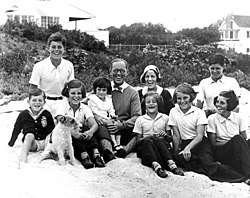
Kennedy requested that surgeons perform a lobotomy on his eldest daughter Rosemary in 1941. Various reasons for the operation have been given, but it left her permanently incapacitated.[69][70][71] He did not inform his wife of this decision until after the procedure was completed.[72] Rosemary's name "was never mentioned in the house", according to Janet DesRosiers Fontaine, Kennedy's secretary and mistress.[73] Dr. Bertram S. Brown, director of the National Institute of Mental Health, said later that Kennedy called his daughter Rosemary mentally retarded rather than mentally ill in order to protect John's reputation for a presidential run, and that the family's "lack of support for mental illness is part of a lifelong family denial of what was really so".[69][74][75][76]
Following the lobotomy, Rosemary was immediately institutionalized.[77] In 1949, she was relocated to Jefferson, Wisconsin, where she lived for the rest of her life on the grounds of the St. Coletta School for Exceptional Children (formerly known as "St. Coletta Institute for Backward Youth").[78] Kennedy did not visit his daughter at the institution.[79] In Rosemary: The Hidden Kennedy Daughter, author Kate Clifford Larson stated that Rosemary's lobotomy was hidden from the family for twenty years.[80] In 1961, after Kennedy suffered a stroke that left him unable to speak, his children were made aware of Rosemary's location.[80] The lobotomy did not become public knowledge until 1987.[81] Rosemary Kennedy died from natural causes[82] on January 7, 2005, at the age of 86.[72]
Illness and death

On December 19, 1961, at the age of 73, Kennedy suffered a stroke. He survived but was left paralyzed on his right side. Thereafter, he suffered from aphasia, which severely affected his ability to speak. He remained mentally alert, regained certain functions with therapy, and began walking with a cane. His speech also showed some improvement.[83] Kennedy began to experience excessive muscular weakness, which eventually required him to use a wheelchair. In 1964, Kennedy was taken to The Institutes for the Achievement of Human Potential in Philadelphia, a medical and rehabilitative center for those who have experienced brain injury.[83]
Kennedy's son Robert was assassinated on June 5, 1968.[84] In the aftermath of his son's death, Kennedy made his last public appearance when he, his wife, and son Ted made a filmed message to the country.[85] He died at home in Hyannis Port the following year on November 18, 1969.[86] He had outlived four of his children.[87] He was buried at Holyhood Cemetery in Brookline, Massachusetts. Kennedy's widow Rose was buried next to him following her death in 1995, as was their daughter Rosemary in 2005.[88]
In popular culture
Kennedy plays a significant role as a character in Winston's War, Michael Dobbs' fictionalized account of the rise of Winston Churchill. In Richard Condon's thriller Winter Kills, Pa Keegan is a fictionalized version of Kennedy, and is portrayed by John Huston in the film version of that novel.
In the alternate history novel Fatherland by Robert Harris, set in 1964, the senior Kennedy—not his son John F. Kennedy—is president of the United States and about to arrive in Berlin to conclude a treaty with Adolf Hitler.
Movies and television
Kennedy has been portrayed by:
- Stephen Elliott in the 1977 movie Young Joe, the Forgotten Kennedy
- E. G. Marshall in the 1983 miniseries Kennedy
- Lloyd Nolan in the 1985 film Prince Jack
- Barry Morse in the 1987 miniseries Hoover vs. The Kennedys
- William Petersen in the 1990 miniseries The Kennedys of Massachusetts
- Josef Sommer in the second episode ("The Kennedy Years") of the 1991 miniseries A Woman Named Jackie
- Terry Kinney in the 1993 TV miniseries JFK: Reckless Youth
- Jan Kohout in the 1994 TV movie Fatherland[89]
- Irish actor Dan O'Herlihy in the 1998 movie The Rat Pack
- Tom Skerritt in the 2000 TV movie Jackie Bouvier Kennedy Onassis
- Tom Wilkinson in the 2011 miniseries The Kennedys
- William Hope in the 2012 Upstairs, Downstairs episode "The Love That Pays the Price"
- Matt Letscher in the HBO series Boardwalk Empire
- Tom Wilkinson in the 2017 miniseries The Kennedys: After Camelot
- Bruce Dern in the 2017 film Chappaquiddick
See also
- Kennedy family
- Kennedy Curse
References
- Richard J. Whalen, The Founding Father, 1964.
- Boston Sunday Globe, November 10, 1940.
- Watson, William E.; Jr, Eugene J. Halus (November 25, 2014). "Irish Americans: The History and Culture of a People: The History and Culture of a People". ABC-CLIO – via Google Books.
- "All the Tragedy That Has Led to Belief in a Kennedy Curse". E! Online. August 2, 2019.
- "The Wedding That Changed American History". Time.
- "Meet Honey Fitz: The 'pixie like' mayor of Boston (and JFK's grandfather)". 17 May 2017.
- David Nasaw, The Patriarch: The Remarkable Life and Turbulent Times of Joseph P. Kennedy (2012) pp. 168-69.
- Okrent, Daniel. "The Biggest Kennedy Myth". The Newsweek/Daily Beast Company LLC. Retrieved 7 April 2013.
- Nasaw, p. 79-81.
- Federal Reserve Bank of Minneapolis. "Consumer Price Index (estimate) 1800–". Retrieved January 1, 2020.
- Smith, Richard Austin (November 1, 1957). "The Fifty-Million-Dollar Man, (sidebar: "America's Biggest Fortunes")". Fortune.
- Kessler, p. 25.
- Kessler, p. 27.
- Goorian, Philip (2002). Green Valley, Arizona. Arcadia Publishing. ISBN 0738520721.
- Beverly Gage, The Day Wall Street Exploded, Oxford University Press, 2009, p. 156.
- Goodwin, Doris Kearns. The Fitzgeralds and the Kennedys (1987) pp. 330–333.
- "Ecommerce: Who wants to be a millionaire", Computer Business Review, February 2000.
- "Essay: The Merits of Speculation", Time, September 22, 1967.
- Kessler, pp. 60–61.
- Ilias Chrissochoidis (ed.), Spyros P. Skouras, Memoirs (1893-1953) (Stanford, 2013), 82.
- Anger, Kenneth (1984). Hollywood Babylon II. New York: E. P. Dutton, Inc. p. 35.
- Kessler, pp. 106–107.
- Beauchamp, Cari (2009) Joseph Kennedy Presents: His Hollywood Years pp. 263–5, Knopf, New York. ISBN 978-1-4000-4000-1.
- Kessler, p. 86.
- Nasaw, p. 611.
- Leamer 308.
- TIMES, Special to THE NEW YORK (22 July 1945). "BIG 'MART' BOUGHT BY JOSEPH KENNEDY; Chicago's Merchandise Block Is Purchased From Marshall Field's" – via NYTimes.com.
- Mario R. Di Nunzio (2011). Franklin D. Roosevelt and the Third American Revolution. ABC-CLIO. p. 55.
- Nasaw, p 208.
- Nasaw, pp 204-37.
- Nassau, The Patriarch, pp 226-28
- "Joseph P. Kennedy - JFK Library". www.jfklibrary.org.
- Society, SEC Historical. "Securities and Exchange Commission Historical Society". www.sechistorical.org.
- Leamer 93; Brinkley 127.
- Maier pp. 103–107.
- Smith pp. 122, 171, 379, 502; Alan Brinkley, Voices of Protest (1984) p. 127; Michael Kazin, The Populist Persuasion (1995) pp. 109, 123.
- JoEllen M Vinyard (June 7, 2011). Right in Michigan's Grassroots: From the KKK to the Michigan Militia. University of Michigan. p. 148. Retrieved July 21, 2018.
kennedy coughlin.
- Joseph Kennedy and the Jews Edward Renehan, Jr., History News Network, accessed July 21, 2018
- Thomas Maier (25 March 2009). The Kennedys: America's Emerald Kings: A Five-Generation History of the Ultimate Irish-Catholic Family. Basic Books. pp. 498–. ISBN 978-0-7867-4016-1.
- Whitehead, Philip (11 October 1992). "The bootleg politician: He could have anything he wanted, except the thing he wanted most. So Joe Kennedy used his money and the vast influence it bought to promote the next generation. But how had he made the fortune that bought the presidency?". The Independent. Retrieved July 12, 2019.
- Hersh 64.
- Hersh 63.
- Davis, John H. (1993). The Kennedys: Dynasty and Disaster. S.P.I. Books. p. 94. ISBN 978-1-56171-060-7.
- Maier, Thomas (October 28, 2014). "When Lions Roar: The Churchills and the Kennedys". Crown – via Google Books.
- Nasaw, pp 492-96, quote p 496.
- Leamer pp. 152–53; William E. Leuchtenburg, In the Shadow of FDR: From Harry Truman to George W. Bush (2001) pp. 68–72.
- Leamer 115.
- Hersh 64; Renehan 29.
- Renehan 60.
- Renehan 26–27; Leamer 136.
- Renehan, "Joseph Kennedy and the Jews".
- Leamer 134.
- Fleming, Thomas. The New Dealers' War: F.D.R. And The War Within World War II, Basic Books, 2001.
- Renehan 311.
- Leamer pp 313, 434; Adam Cohen and Elizabeth Taylor. American Pharaoh: Mayor Richard J. Daley -- His Battle for Chicago and the Nation (2001) p. 250; Timothy J. Meagher. The Columbia Guide to Irish American History (2005) p. 150.
- Leamer p. 349.
- William Edward Leuchtenburg (2001). In the Shadow of FDR: From Harry Truman to George W. Bush. Cornell University Press. pp. 80–. ISBN 0-8014-8737-4.
- Kakutani, Michiko (1996-05-24). "Kennedy and Nixon: An Uneasy Relationship". The New York Times. Retrieved 1 August 2013.
- Michael O'Brien, John F. Kennedy: A Biography (2005), 250–54, 274–79, 396–400; Thomas C. Reeves, The Life and Times of Joe McCarthy (1982), 442–3; Maier, The Kennedys 270–280.
- Beauchamp, Cari. "Two Sons, One Destiny". The Hive.
- "Parents at the Inaugurations – Presidents' Parents". Presidentsparents.com. Retrieved 2014-05-09.
- Kessler, p. 389.
- "Eunice Kennedy Shriver's Death Leaves 2 Living Kennedy Siblings". Associated Press. 25 March 2015.
- Baranauckas, Carla (11 August 2009). "Eunice Kennedy Shriver, Influential Founder of Special Olympics, Dies at 88" – via NYTimes.com.
- "Last living sibling of John F. Kennedy celebrates her 91st birthday". IrishCentral.com. 20 February 2019.
- "Kennedy and Swanson, as if We Didn't Know: AND JOE The Star-Crossed Love Affair of Gloria Swanson and Joe Kennedy by Axel Madsen (William Morrow/Arbor House: $18.95; 328 pp., illustrated)". 14 February 1988 – via LA Times.
- Beauchamp, Cari. "It Happened at the Hotel du Cap". The Hive.
- EDT, Mark Hosenball On 10/5/97 at 8:00 PM (5 October 1997). "The Jfk-Marilyn Hoax". Newsweek.
- Block, Jennie Weiss (2002). Copious hosting: a theology of access for people with disabilities. Continuum International Publishing Group. p. 56.
- Shorter, Edward. The Kennedy Family and the History of Mental Retardation. Temple University Press via Amazon.com Look Inside. pp. 32–33. ISBN 1-56639-783-9.
- Murawski and Spencer, p. 3.
- Cornwell, Rupert (10 January 2005). "Obituaries: Rosemary Kennedy". The Independent. Retrieved 24 January 2013.
- Kessler, pp. 2, 247.
- Kessler, pp. 252–253.
- Shorter, Edward. The Kennedy Family and the History of Mental Retardation. Temple University Press via Amazon.com Look Inside. pp. 32–33. ISBN 1566397839.
- Murawski, Wendy W.; Spencer, Sally (2011). Collaborate, Communicate, and Differentiate!: How to Increase Student Learning in Today's Diverse Schools. Corwin Press. p. 3.
- Leamer, p. 322.
- Leamer, p. 412, and caption to photo of the house facing p. 650.
- Collier, Peter; Horowitz, David (1984). The Kennedys. Summit Books. p. 116. ISBN 978-0-671-44793-9.
- "Why Rosemary Kennedy's Siblings Didn't See Her for 20 Years After Her Lobotomy". PEOPLE.com.
- "Remembering the sad and dreadful life of Rosemary Kennedy". IrishCentral.com. January 7, 2019.
- "Sister of President John F Kennedy dies". The Daily Telegraph. 8 January 2005. Retrieved 24 January 2013.
- "People: May 22, 1964", Time, May 22, 1964.
- "RFK 50 years later: A look back at the assassination of Bobby Kennedy". NBC News.
- "June 15, 1968 - Edward & Rose Kennedy thanks the nation following Robert F. Kennedy's assassination". YouTube.
- Kakutani, Michiko (29 November 2012). "David Nasaw's 'Patriarch,' on Joseph P. Kennedy" – via NYTimes.com.
- scraper, I'm a (13 November 2012). "Book Review: Joseph Kennedy Biography by David Nasaw".
- Katz, Alex; Andersen, Travis (22 September 2011). "Friends, family bid farewell to Kennedy in D.C., Brookline" – via The Boston Globe.
- "Fatherland (TV Movie 1994)" – via www.imdb.com.
Bibliography
- Brinkley, Alvin. Voices of Protest. Vintage, 1983.
- Goodwin, Doris K. The Fitzgeralds and the Kennedys: An American Saga. Simon & Schuster, 1987.
- Hersh, Seymour. The Dark Side of Camelot. Back Bay Books, 1998.
- Kessler, Ronald. The Sins of the Father: Joseph P. Kennedy and the Dynasty He Founded. Warner, 1996
- Leamer, Laurence. The Kennedy Men: 1901–1963. Harper, 2002.
- Maier, Thomas. The Kennedys: America's Emerald Kings. Basic Books, 2003.
- Nasaw, David. The Patriarch: The Remarkable Life and Turbulent Times of Joseph P. Kennedy. The Penguin Press, 2012
- O'Brien, Michael. John F. Kennedy: A Biography. St Martin's Press, 2005.
- Renehan, Edward. The Kennedys at War: 1937–1945. Doubleday, 2002.
- Renehan, Edward. "Joseph Kennedy and the Jews". History News Network. George Mason University, April 29, 2002.
- Schwarz, Ted. Joseph P. Kennedy: The Mogul, the Mob, the Statesman, and the Making of an American Myth. Wiley, 2003.
- Smith, Amanda (ed.). Hostage to Fortune: The Letters of Joseph P. Kennedy. Viking, 2001, the major collection of letters to and from Kennedy
- Whalen, Richard J. The Founding Father: The Story of Joseph P. Kennedy. The New American Library of World Literature, Inc., 1964.
External links
- Joseph P. Kennedy Sr. on IMDb
- The Kennedys – PBS Special
- FBI files on Joseph P. Kennedy Sr.
- Affair with Marlene Dietrich
- Correspondence with the Secretary of State at the Franklin D. Roosevelt Library
- "Joseph P. Kennedy Sr". Find a Grave. Retrieved 2015-07-25.
- Newspaper clippings about Joseph P. Kennedy Sr. in the 20th Century Press Archives of the ZBW
| Government offices | ||
|---|---|---|
| New office | Chair of the U.S. Securities and Exchange Commission 1934–1935 |
Succeeded by James M. Landis |
| Diplomatic posts | ||
| Preceded by Robert Worth Bingham |
United States Ambassador to the United Kingdom 1938–1940 |
Succeeded by John G. Winant |
